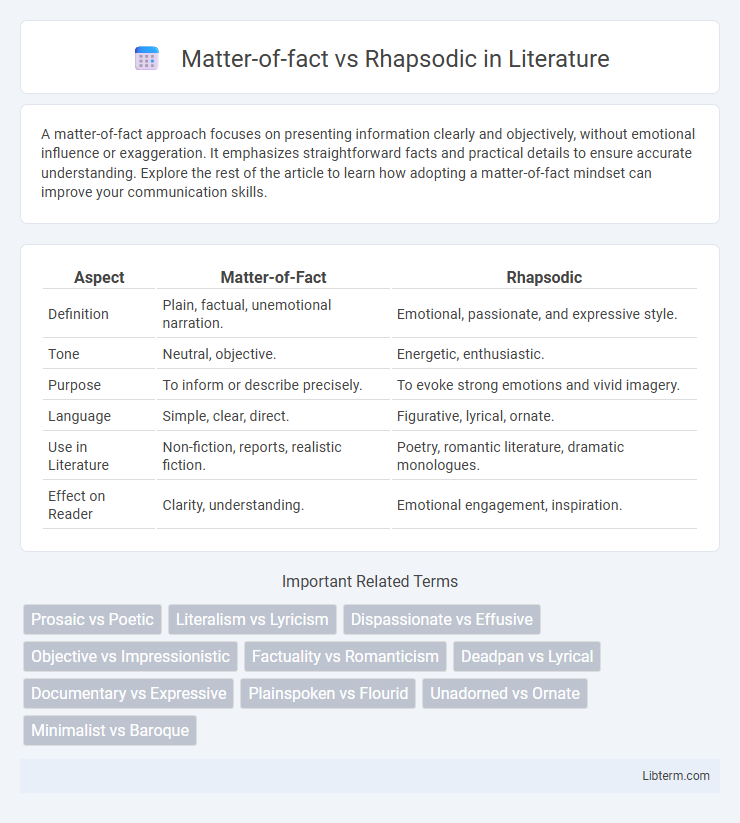A matter-of-fact approach focuses on presenting information clearly and objectively, without emotional influence or exaggeration. It emphasizes straightforward facts and practical details to ensure accurate understanding. Explore the rest of the article to learn how adopting a matter-of-fact mindset can improve your communication skills.
Table of Comparison
| Aspect | Matter-of-Fact | Rhapsodic |
|---|---|---|
| Definition | Plain, factual, unemotional narration. | Emotional, passionate, and expressive style. |
| Tone | Neutral, objective. | Energetic, enthusiastic. |
| Purpose | To inform or describe precisely. | To evoke strong emotions and vivid imagery. |
| Language | Simple, clear, direct. | Figurative, lyrical, ornate. |
| Use in Literature | Non-fiction, reports, realistic fiction. | Poetry, romantic literature, dramatic monologues. |
| Effect on Reader | Clarity, understanding. | Emotional engagement, inspiration. |
Introduction to Matter-of-Fact and Rhapsodic Styles
Matter-of-fact style emphasizes clear, concise, and objective communication, prioritizing straightforward facts and logical structure without emotional embellishment. Rhapsodic style, in contrast, is characterized by expressive, enthusiastic language that conveys intense emotions and vivid imagery, often aiming to inspire or captivate the audience. Understanding these distinct styles enhances effective communication by aligning tone with purpose, whether presenting data or evoking passion.
Defining Matter-of-Fact Communication
Matter-of-fact communication employs clear, concise language focused on delivering information without emotional embellishment, ensuring precise understanding. This style prioritizes factual accuracy and straightforwardness, often used in professional or technical contexts to avoid ambiguity. It contrasts with rhapsodic communication, which emphasizes emotional expression and vivid, poetic language to evoke feelings.
Exploring the Rhapsodic Approach
The rhapsodic approach embraces expressive, vivid language that evokes strong emotions and paints rich imagery, contrasting sharply with the straightforward, objective tone of the matter-of-fact style. This method prioritizes subjective experience and imaginative storytelling, often used in poetry, literary fiction, and artistic reviews to engage readers on a deeper emotional level. Exploring the rhapsodic approach reveals its power to inspire creativity and connect audiences through immersive, evocative narratives.
Key Differences Between the Two Styles
Matter-of-fact style presents information in a straightforward, objective manner, emphasizing clarity and precision without emotional embellishment. Rhapsodic style, in contrast, is characterized by expressive, enthusiastic language that evokes strong emotions and vivid imagery. The key differences lie in tone and purpose: matter-of-fact aims for neutrality and factual accuracy, while rhapsodic seeks to inspire and captivate through passionate expression.
Historical Contexts and Evolution
Matter-of-fact communication, characterized by objective and straightforward expression, has roots in classical rhetoric and the Age of Enlightenment, emphasizing clarity and rationality in conveying information. Rhapsodic style, with its emotional and lyrical intensity, originates from ancient oral traditions and Romanticism, where expressive narrative and vivid imagery aimed to evoke strong emotional responses. Over time, historical contexts shaped these communication modes: matter-of-fact evolved to support scientific discourse and legal documentation, while rhapsodic persisted in artistic and literary realms as a vehicle for personal and cultural storytelling.
Advantages of a Matter-of-Fact Tone
A matter-of-fact tone enhances clarity and precision by presenting information in a straightforward manner, reducing ambiguity and misunderstanding. It fosters credibility and professionalism, making communication more persuasive and trustworthy in academic, legal, or technical contexts. This tone also streamlines decision-making processes by focusing on facts rather than emotional embellishments.
Benefits of Using a Rhapsodic Voice
Using a rhapsodic voice enhances storytelling by evoking strong emotions and creating vivid imagery that deeply engages the audience. This expressive style fosters a memorable connection, making complex ideas more relatable and impactful. Rhapsodic communication often sparks inspiration and enthusiasm, driving motivation and creative thinking.
Choosing the Right Style for Your Audience
Selecting the appropriate communication style depends on understanding your audience's preferences and the context of the message. A matter-of-fact style suits professional or technical settings where clarity and precision are essential, while a rhapsodic style engages audiences through emotional appeal and vivid storytelling, ideal for creative or persuasive contexts. Tailoring your approach enhances message impact and ensures effective connection with listeners or readers.
Practical Examples: Matter-of-Fact vs Rhapsodic in Action
Matter-of-fact communication presents information with clear, straightforward language, often seen in technical reports or news briefs where accuracy and neutrality are essential. Rhapsodic expression features emotive, vivid language conveying passion or enthusiasm, commonly found in poetry, speeches, or artistic critiques. For example, a weather report uses a matter-of-fact style: "The temperature today is 75 degrees with a 10% chance of rain," while a rhapsodic description might say, "The sun bathes the landscape in a golden, warm embrace, promising a day of radiant beauty."
Conclusion: Harmonizing Both Approaches
Harmonizing matter-of-fact and rhapsodic approaches enhances communication by balancing clarity with emotional impact, enabling messages to resonate logically and emotionally. Integrating factual precision with expressive enthusiasm fosters deeper engagement and understanding, appealing to diverse audiences. This synergy drives effective storytelling and decision-making across professional and creative contexts.
Matter-of-fact Infographic

 libterm.com
libterm.com